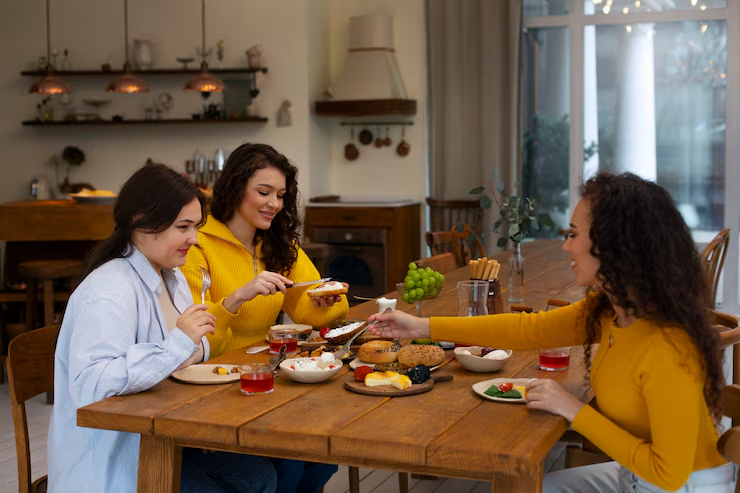
How to Manage Family Meals with Different Dietary Needs
Cooking for a family with different dietary requirements can feel like a daily puzzle. Whether you’re juggling vegetarian and meat-based meals, food allergies, or personal preferences, it may seem overwhelming.
The good news? With some planning and a little creativity, you can manage multiple diet family meals, create a balanced household diet, and enjoy stress-free inclusive meal planning for everyone at the table.
Pro Tip: The goal isn’t to make entirely separate meals but to find ways to customise a shared base recipe.
Quick Guide: Why Planning Matters
- Saves time and reduces kitchen stress
- Prevents accidental exposure to allergens
- Avoids last-minute mealtime disagreements
- Helps ensure balanced nutrition for all family members
- Encourages respect and understanding of dietary choices
Important: Communication and planning are key to success.
Step-by-Step: How to Manage Meals for Different Diets
Step 1: Identify All Dietary Needs
Have an open discussion with your family.
Common requirements include:
- Vegetarian or vegan
- Gluten-free
- Dairy-free or lactose intolerant
- Nut allergies
- Low-sodium or diabetic diets
- Picky eaters or personal preferences
Quick Tip: Write down each person’s restrictions and preferences to avoid confusion.
Step 2: Focus on Common Ingredients
Start with ingredients everyone can eat.
| Food Type | Family-Friendly Options |
| Grains | Rice, quinoa, oats |
| Vegetables | Most fresh or steamed vegetables |
| Legumes | Lentils, chickpeas, beans |
| Protein (optional add-ons) | Tofu, chicken, fish, eggs |
Pro Tip: Building meals around vegetables, grains, and legumes makes customising easier.
Step 3: Create Base Meals with Customisable Options
This is the heart of inclusive meal planning.
Examples:
| Base Meal | Customisation |
| Tacos | Offer meat, beans, dairy-free and regular cheese, gluten-free wraps |
| Pasta Night | Separate plain pasta and sauces (vegan, meat, creamy) |
| Stir-Fry | Mix vegetables; add protein options like tofu, chicken, or prawns |
| Buddha Bowls | Offer grains + toppings: veggies, seeds, sauces, proteins |
Quick Tip: Serve “deconstructed meals” where everyone assembles their own plate.
Step 4: Meal Plan in Advance
Plan your meals weekly to avoid last-minute stress.
- Use a family calendar
- Let each person choose one dinner a week
- Plan ahead for school lunches or snacks
Pro Tip: Keep a folder or app with recipes that work well for your family’s mix of diets.
Step 5: Keep Meals Simple
Simplicity saves time and reduces the chance of mistakes.
- Stick to recipes with fewer ingredients
- Prepare meals that cook well in bulk
- Avoid overcomplicated substitutions
Quick Tip: One-pot dishes (soups, stews, curries) are versatile and easily customisable.
Step 6: Prepare Ingredients Separately
Cook and store ingredients individually.
- Steam or roast vegetables in separate trays
- Cook grains in large batches and portion
- Marinate meats and plant proteins separately
Ingredient Prep Tip Grains Cook in advance and store for 3–4 days Vegetables Chop ahead and keep in airtight containers Sauces/Dressings Keep in jars for easy additions at mealtime Sustainability Note: Batch cooking helps reduce waste and saves energy.
Step 7: Create a Safe Cooking Environment for Allergies

If managing serious allergies:
- Designate colour-coded chopping boards and utensils
- Store allergen-free ingredients separately
- Wash hands and equipment thoroughly between tasks
Pro Tip: Read labels carefully. Even “hidden” ingredients can cause a reaction.
Step 8: Get the Family Involved
Engage everyone in meal prep.
- Assign age-appropriate kitchen tasks
- Let children help choose recipes
- Encourage teens to experiment with cooking their own meals
Quick Tip: Involvement leads to ownership, making even picky eaters more willing to try new foods.
Common Meal Planning Hacks for Multiple Diets
Hack Benefit Double batch meals Saves time later in the week Freeze extras Perfect for busy nights Keep staple ingredients on hand Reduces trips to the shop Rotate family favourites Prevents meal fatigue Keep a snack station Offers safe grab-and-go options for all diets Common Mistakes to Avoid
Mistake Solution Trying to make completely separate meals Build customisable meals from a shared base Forgetting to label foods Use sticky notes or labels on leftovers Ignoring hidden ingredients Always check food labels carefully Not involving the family Let everyone help to reduce your workload Overcomplicating meals Simplicity = sustainability in the kitchen Frequently Asked Questions

Can I really cook for different diets at once?
Yes. Customisable meals and ingredient separation make it manageable.How can I make one meal that works for everyone?
Plan “build your own” meals like burrito bowls, tacos, or salads.Is meal planning more expensive with special diets?
Not necessarily. Planning reduces waste and unnecessary shopping.What if I don’t have time to meal prep?
Start small. Even prepping a few ingredients ahead saves time during the week.How do I handle allergies with other preferences?
Always prioritise safety first. Keep allergy-free foods separate from optional extras.Make Mealtimes Work for Everyone
With a little planning and flexibility, managing multiple diet family meals doesn’t have to be stressful. By focusing on shared ingredients, creating customisable meals, and using a balanced household diet approach, you can master inclusive meal planning with ease.
Stay organised. Stay flexible. Keep family mealtimes happy and safe for all.


